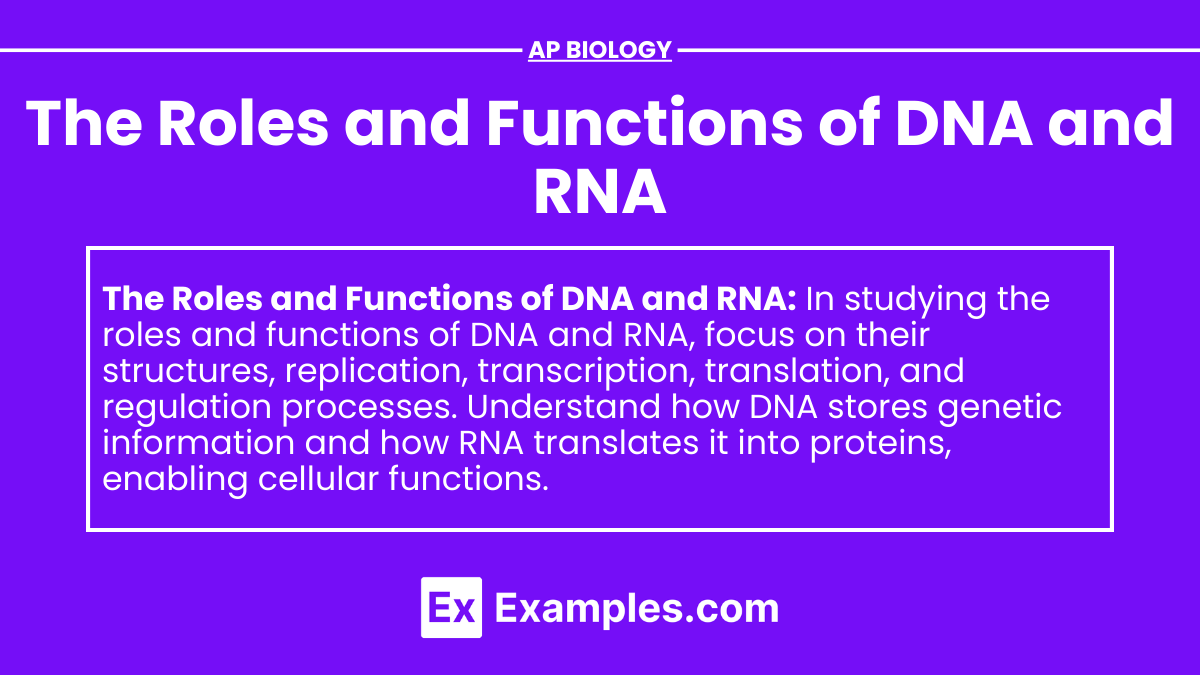In AP Biology, understanding the fundamental roles and functions of DNA and RNA is crucial. DNA, located primarily in the nucleus, stores genetic information essential for the development, function, and reproduction of all living organisms. RNA plays a vital role in translating this genetic code into proteins. Together, DNA and RNA orchestrate the complex processes of gene expression, regulation, and protein synthesis, ensuring the proper functioning of cells.
Learning Objectives
By studying the roles and functions of DNA and RNA, you will understand how the nucleolus synthesizes rRNA and assembles ribosomal subunits. You will comprehend how genetic information regulates the cell cycle and recognize the function of ribosomes in protein synthesis. Additionally, you will explore how nucleotides, containing phosphorus, are integral to both DNA and RNA, linking these processes to the phosphorus cycle.
Structure of DNA and RNA
DNA Structure
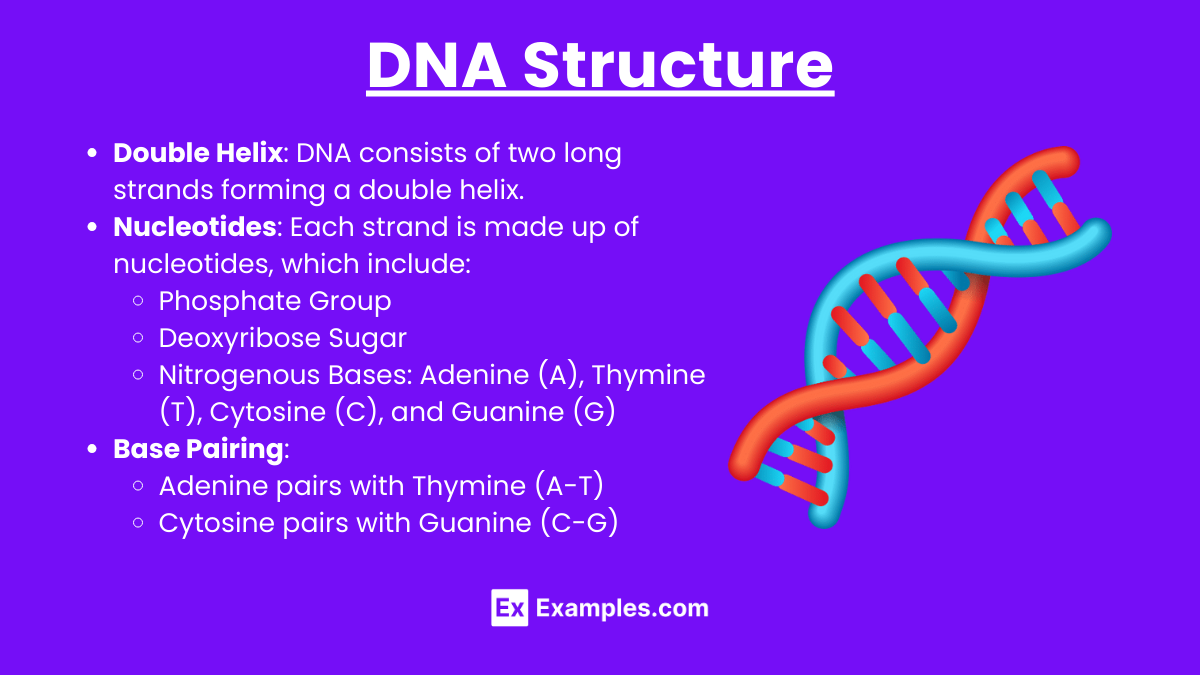
- Double Helix: DNA consists of two long strands forming a double helix.
- Nucleotides: Each strand is made up of nucleotides, which include:
- Phosphate Group
- Deoxyribose Sugar
- Nitrogenous Bases: Adenine (A), Thymine (T), Cytosine (C), and Guanine (G)
- Base Pairing:
- Adenine pairs with Thymine (A-T)
- Cytosine pairs with Guanine (C-G)
RNA Structure
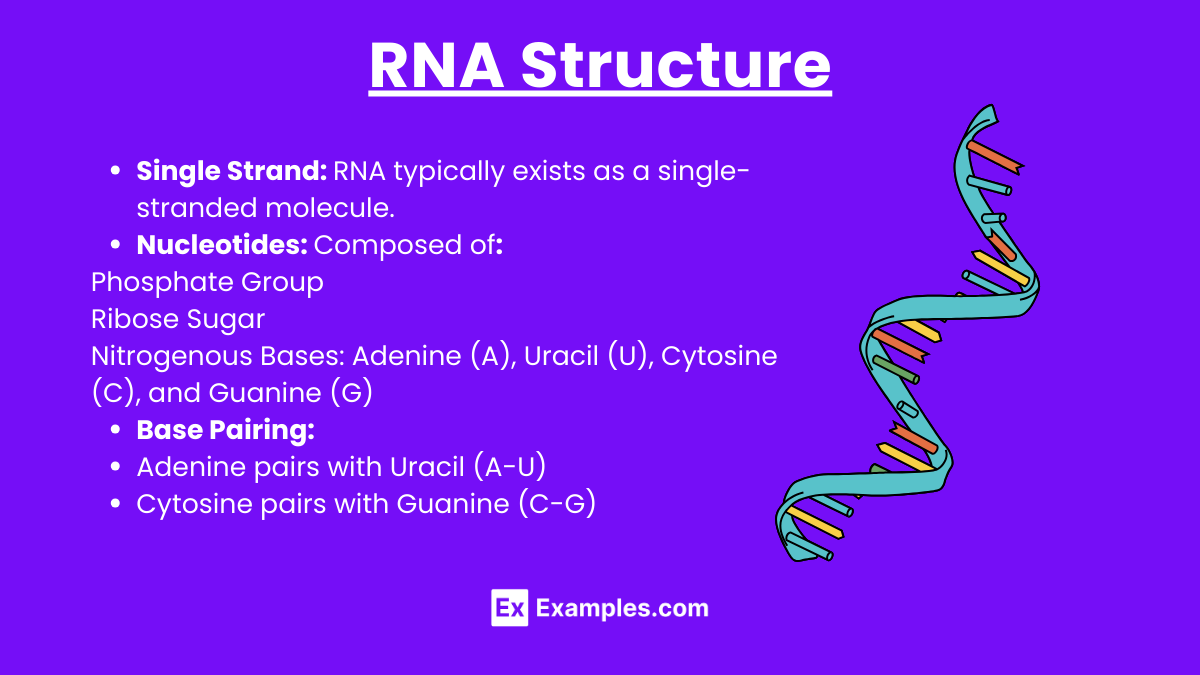
- Single Strand: RNA typically exists as a single-stranded molecule.
- Nucleotides: Composed of:
- Phosphate Group
- Ribose Sugar
- Nitrogenous Bases: Adenine (A), Uracil (U), Cytosine (C), and Guanine (G)
- Base Pairing:
- Adenine pairs with Uracil (A-U)
- Cytosine pairs with Guanine (C-G)
Functions of DNA
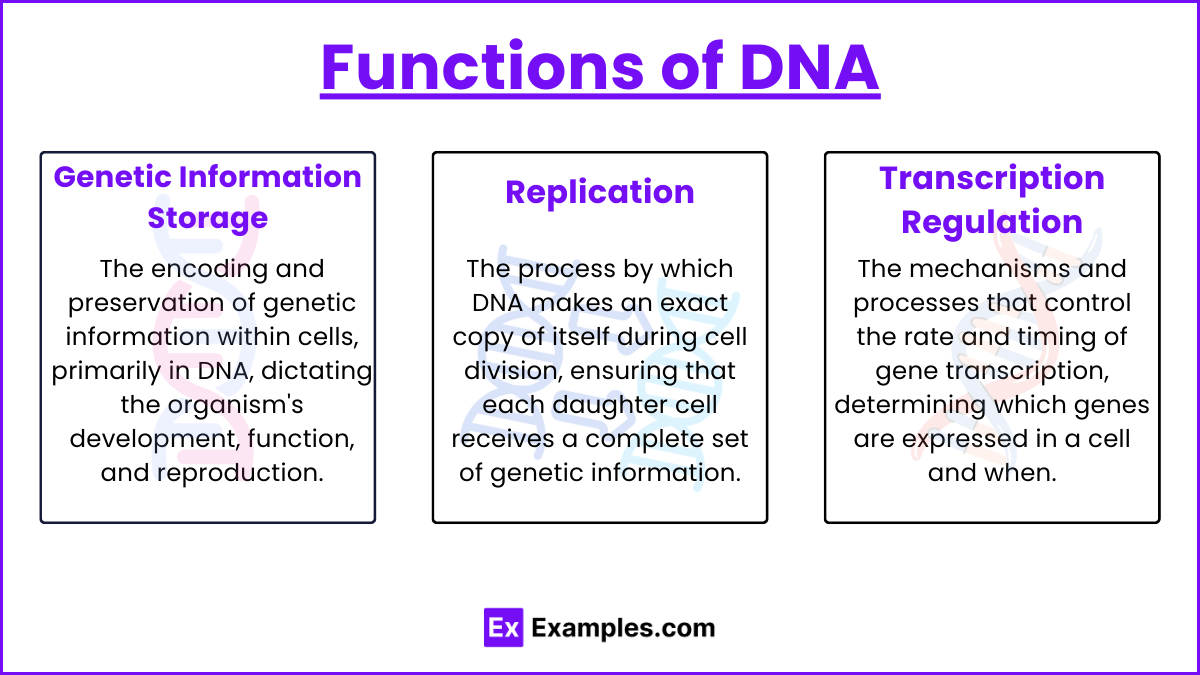
Genetic Information Storage
- Genome: DNA contains the entire genetic blueprint of an organism.
- Genes: Segments of DNA that encode for proteins or functional RNA molecules.
Replication
- Semi-Conservative Process: Each new DNA molecule consists of one old and one new strand.
- Enzymes Involved:
- DNA Helicase: Unwinds the DNA double helix.
- DNA Polymerase: Adds nucleotides to the growing DNA strand.
- DNA Ligase: Joins Okazaki fragments on the lagging strand.
Transcription Regulation
- Promoters and Enhancers: Specific DNA sequences that regulate gene expression.
- Transcription Factors: Proteins that bind to DNA and influence RNA polymerase activity.
Functions of RNA
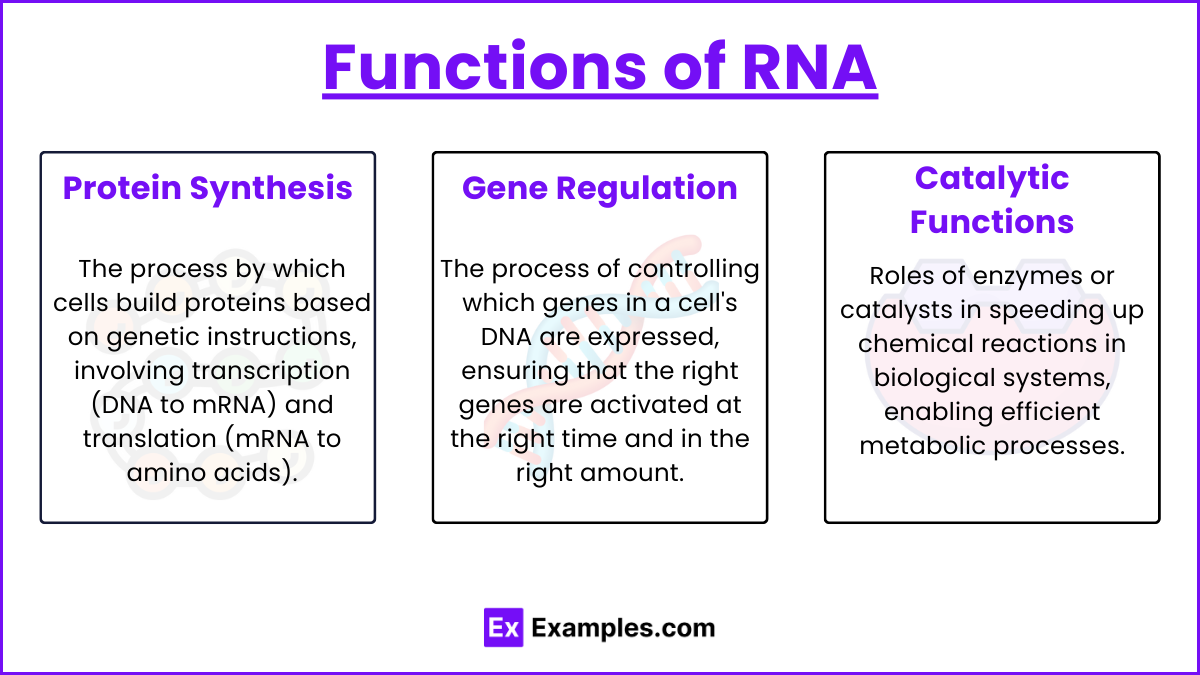
Protein Synthesis
- Messenger RNA (mRNA): Carries genetic information from DNA to ribosomes for protein synthesis.
- Transfer RNA (tRNA): Brings amino acids to the ribosomes during translation.
- Ribosomal RNA (rRNA): Makes up the ribosomes, the site of protein synthesis.
Gene Regulation
- MicroRNA (miRNA) and Small Interfering RNA (siRNA): Involved in RNA interference, a process that regulates gene expression by degrading mRNA or blocking its translation.
Catalytic Functions
- Ribozymes: RNA molecules with enzymatic activity, such as the ribosome’s peptidyl transferase activity.
Key Processes Involving DNA and RNA

Transcription
- Initiation: RNA polymerase binds to the promoter region of DNA.
- Elongation: RNA polymerase synthesizes mRNA by adding RNA nucleotides complementary to the DNA template strand.
- Termination: RNA polymerase reaches a terminator sequence and releases the newly synthesized mRNA.
Translation
- Initiation: mRNA binds to the ribosome, and the first tRNA molecule pairs with the start codon (AUG).
- Elongation: tRNA molecules bring amino acids to the ribosome, matching codons on the mRNA.
- Termination: A stop codon is reached, and the polypeptide chain is released.
DNA Replication
- Unwinding: DNA helicase unwinds the double helix.
- Primer Binding: RNA primase synthesizes an RNA primer to start the replication process.
- Elongation: DNA polymerase adds nucleotides to the growing DNA strand.
- Termination: Replication ends when the entire DNA molecule is copied.
Regulation of Gene Expression
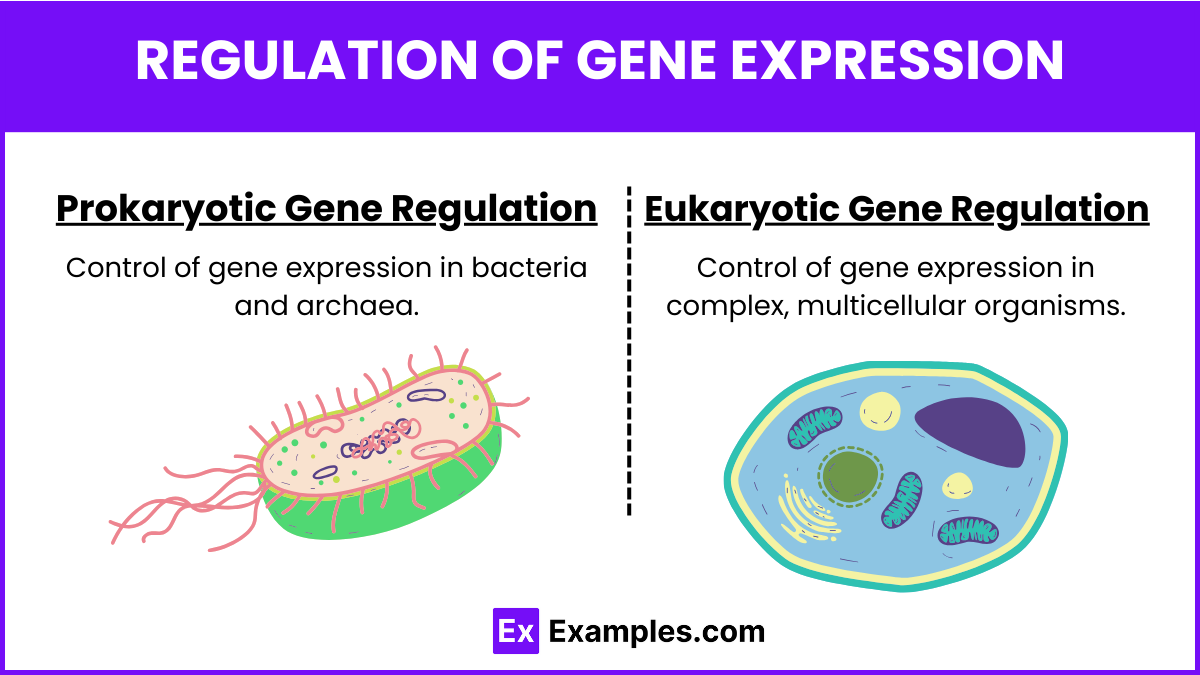
Prokaryotic Gene Regulation
- Operons: Clusters of genes with a single promoter.
- Lac Operon: Inducible operon activated by the presence of lactose.
- Trp Operon: Repressible operon inhibited by the presence of tryptophan.
Eukaryotic Gene Regulation
- Chromatin Structure:
- Histone Modification: Acetylation (activates transcription), methylation (can activate or repress).
- DNA Methylation: Typically represses gene expression.
- Transcriptional Control:
- Enhancers: DNA sequences that increase transcription.
- Silencers: DNA sequences that repress transcription.
- Post-Transcriptional Control:
- Alternative Splicing: Produces different mRNA variants from the same gene.
- mRNA Stability: Influenced by sequences in the mRNA.
- Translational Control:
- Regulatory Proteins: Bind to mRNA and affect translation.
- Post-Translational Control:
- Protein Modification: Alters activity, stability, or localization.
Examples
- Example 1: DNA Replication
- Process: During the S phase of the cell cycle, DNA polymerase replicates DNA, ensuring each daughter cell receives an identical set of DNA.
- Importance: Ensures genetic continuity across generations of cells.
- Example 2: Transcription and mRNA Processing
- Process: RNA polymerase transcribes DNA into mRNA, which is then processed by adding a 5′ cap, poly-A tail, and splicing out introns.
- Importance: Produces mature mRNA for translation, regulating gene expression.
- Example 3: Translation and Protein Synthesis
- Process: Ribosomes translate mRNA into a polypeptide chain, with tRNA bringing amino acids corresponding to each codon.
- Importance: Synthesizes proteins essential for cellular function and structure.
- Example 4: Gene Regulation – Lac Operon
- Process: In the presence of lactose, the lac operon is activated to produce enzymes for lactose metabolism.
- Importance: Demonstrates how genes can be turned on or off in response to environmental changes.
- Example 5: Mutation Effects
- Process: A point mutation in the hemoglobin gene leads to sickle cell anemia, changing one amino acid in the hemoglobin protein.
- Importance: Highlights the impact of genetic changes on phenotype and health
Practice Questions and Answers
Question 1
How does the structure of DNA enable it to replicate accurately during cell division?
A. The single-strand structure allows easy access for enzymes.
B. The double helix structure, consisting of two complementary strands, ensures accurate replication.
C. DNA is made of proteins that guide replication.
D. The circular shape of DNA ensures precision in replication.
Answer: B. The double helix structure, consisting of two complementary strands, ensures accurate replication.
Explanation: The double helix structure of DNA allows for accurate replication because each strand serves as a template for a new complementary strand. DNA helicase unwinds the helix, and DNA polymerase adds nucleotides, matching adenine with thymine and cytosine with guanine. This semi-conservative replication ensures that each new DNA molecule has one old and one new strand, maintaining genetic fidelity.
Question 2
Describe the process by which genetic information in DNA is transcribed into RNA.
A. DNA directly converts into proteins.
B. RNA polymerase unwinds DNA and synthesizes RNA without any additional steps.
C. RNA polymerase binds to the promoter, synthesizes RNA, and the primary transcript undergoes modifications.
D. DNA and RNA combine to form proteins.
Answer: C. RNA polymerase binds to the promoter, synthesizes RNA, and the primary transcript undergoes modifications.
Explanation: Transcription involves RNA polymerase binding to the promoter region of DNA, initiating RNA synthesis. RNA polymerase then unwinds the DNA and elongates the RNA molecule by adding nucleotides complementary to the DNA template strand. After reaching a terminator sequence, transcription ends. In eukaryotes, the RNA transcript undergoes further modifications, including the addition of a 5′ cap, a poly-A tail, and splicing out introns to form mature mRNA.
Question 3
Explain the role of mRNA, tRNA, and rRNA in the process of translation.
A. mRNA carries DNA to the ribosome, tRNA synthesizes RNA, and rRNA transports amino acids.
B. mRNA carries the genetic code, tRNA brings amino acids, and rRNA forms ribosomes.
C. mRNA and tRNA both carry amino acids, while rRNA reads the genetic code.
D. mRNA, tRNA, and rRNA all form part of the DNA structure.
Answer: B. mRNA carries the genetic code, tRNA brings amino acids, and rRNA forms ribosomes.
Explanation: Translation involves mRNA carrying the genetic code from DNA to the ribosome, where it is read in codons. tRNA matches its anticodon with mRNA codons, bringing the corresponding amino acids. rRNA, a major component of ribosomes, ensures proper alignment of mRNA and tRNA and catalyzes peptide bond formation, facilitating the addition of amino acids to the growing polypeptide chain according to the mRNA sequence.

